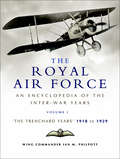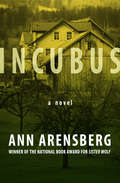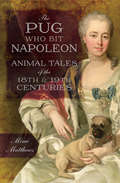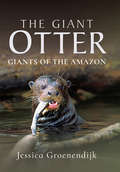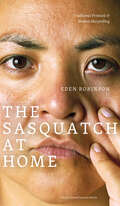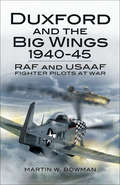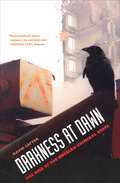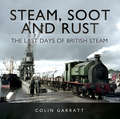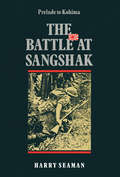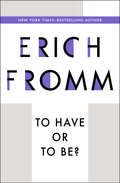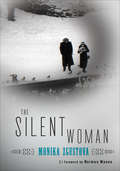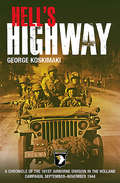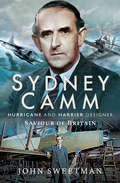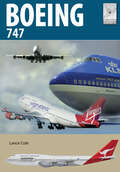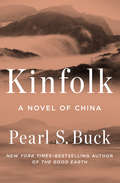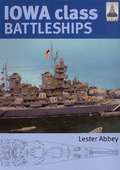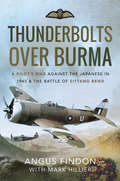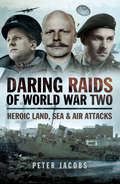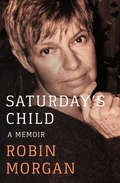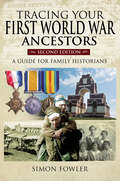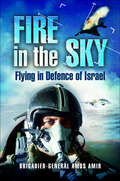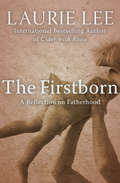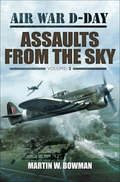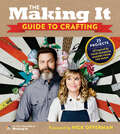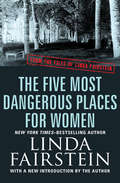- Table View
- List View
The Royal Air Force: An Encyclopaedia Of The Raf Between The Two World Wars - 1918 To 1929 (The Encyclopedia of the Inter-War Years #1)
by Ian M. PhilpottThe inter-war years between 1918 and 1939 saw the newly created Royal Air Force fighting for its very existence politically, being dispatched to the remotest corners of the British Empire and its Protectorates in various policing roles and then finally engaged in a headlong rush to modernize in the face of the new German Fascist regime that was threatening British and European freedom. Yet this important period in RAF history and its effect on political and military rationale during the period has never been completely documented. This exhaustive and comprehensive reference is the most detailed work to be published on the subject. The author gives full information on the changing structure of the Force during the period, squadron operations, political machinations and their effects, the airplanes and their equipment, the personnel, technical advances in navigation and breakthroughs achieved in engine performance. The book is cross-referenced throughout, extremely well illustrated and contains an abundance of location maps and other diagrams. This book will become a Bible for anyone interested in the history of the RAF.This work has been reviewed by personnel at the RAF Historical Branch who praise it.
Incubus: A Novel
by Ann ArensbergNational Book Award winner Ann Arensberg brings readers a modern horror story about evil descending on an insular Maine townIt begins with the theft of six candles from the church altar, a few herbs found strewn in the local graveyard. In the summer of 1974, the prosperous farming community of Dry Falls, Maine, is hit by a brutal heat wave. Crops fail. Drought blights once-verdant lawns. Men inexplicably lose all interest in sex, while women complain of erotic nocturnal visitations. Farm animals give birth to monstrosities. An unholy, unimaginable force is disrupting the natural order—and it seems to be specifically targeting Dry Falls.Narrated by the careful and practical Cora Whitman, wife of the town pastor, this tale of creeping strangeness quickly turns sinister. Incubus subtly builds to its shattering climax with Cora at its epicenter. Expertly interweaving themes of faith, religion, and marriage with that of the supernatural, this modern horror classic will enthrall fans of Ann Arensberg and attract a legion of new readers.
The Pug Who Bit Napoleon: Animal Tales of the 18th & 19th Centuries
by Mimi MatthewsFrom Victorian cat funerals to a Regency-era pony who took a ride in a hot air balloon, a collection of history&’s quirkiest—and most poignant—animal tales. Meet Fortune, the Pug who bit Napoleon on his wedding night, and Looty, the Pekingese sleeve dog who was presented to Queen Victoria after the 1860 sacking of the Summer Palace in Peking. The four-legged friends of Lord Byron, Emily Brontë, and Prince Albert also make an appearance, as do the treasured pets of Alexander Pope, Samuel Johnson, and Charles Dickens. Less famous, but no less fascinating, are the animals that were the subject of historical lawsuits, scandals, and public curiosity. There&’s Tuppy, the purloined pet donkey; Biddy, the regimental chicken; and Barnaby and Burgho, the bloodhounds hired to hunt Jack the Ripper. Wild animals also get a mention in tales that encompass everything from field mice and foxes to alligators and sharks lurking in the Thames. Using research from eighteenth- and nineteenth-century books, letters, and newspapers, Mimi Matthews brings each animal&’s unique history to vivid life. The details are sometimes humorous, sometimes heartbreaking, but the stories are never anything less than fascinating reading for animal lovers of all ages.
The Giant Otter: Giants of the Amazon
by Jessica Groenendijk&“The charisma of these huge, Amazonian &‘river people&’ burns through even the most factual descriptions, emphasized by an abundance of photographs.&” —BBC Wildlife The aptly named giant otter is exceptionally well adapted to life in rivers, lakes and wetlands in tropical South America. Known in Spanish as lobo del rio or &‘river wolf,&’ it can be as long as a human is tall and is the most social of the world&’s thirteen otter species. Each individual is identifiable from birth by its pale throat pattern, as unique as your fingerprint. Giant otters are top carnivores of the Amazon rainforest and have little to fear . . . except man. There are many reasons why scientists and tourists alike are fascinated by this charismatic species. Spend a day in the life of a close-knit giant otter family and you&’ll realize why. Learn about their diet and hunting techniques, marking and denning behavior, and breeding and cub-rearing strategies, including shared care of the youngest members. Become familiar with the complex life histories of individual otters over their 15-year lifespans. And accompany a young disperser during the trials and tribulations of a year spent looking for a mate and a home of its own. &“The descriptions of the otters, their habits and their homes along with tons of jaw dropping photographs, made me feel (almost) like I was there myself. Treat yourself to a book that will transport you to a place like nowhere else on earth, where you explore the wilds of the Amazon from your own garden.&” —Cayocosta 72 &“An intimate, educational and a dedicated love letter to the Giant Otter.&” —Queen of Geekdom
The Sasquatch at Home: Traditional Protocols & Modern Storytelling (The Henry Kreisel Memorial Lecture Series)
by Eden RobinsonThe award-winning Indigenous author of Monkey Beach shares tales from her family, her life, and her culture.In March 2010 the Canadian Literature Centre hosted award-winning novelist and storyteller Eden Robinson at the 4th annual Henry Kreisel Lecture. Robinson shared an intimate look into the intricacies of family, culture, and place through her talk, “The Sasquatch at Home.” Robinson’s disarming honesty and wry irony shine through her depictions of her and her mother’s trip to Graceland, the Potlatch where she and her sister received their Indian names, how her parents first met in Bella Bella (Waglisla, British Columbia) and a wilderness outing where she and her father try to get a look at b’gwus, the Sasquatch. Readers of memoir; Indigenous literatures, histories and cultures; and fans of Robinson’s delightful, poignant, sometimes quirky tales will love The Sasquatch at Home.“[Robinson] strikes sweetly at the commonality of people rather than narrowing in on cultural differences. The entire book is fast, colloquial, and engaging; concise enough to be read in one sitting, yet retaining the weightiness of a larger work. Its brevity makes it an ideal re-read and the second reading proves just as entertaining. The funny parts remain funny, the rendering of landscapes evocative and intimate, and the general themes stay relevant. Through rich and often comic dialogue and her painterly descriptions of the northwest landscape, Eden Robinson presents a glimpse into her community with the delicious, whispered quality of a well-told, yet well-protected, family story.” —Cara-Lyn Morgan, The Malahat Review, Winter 2011“Offers the reader a taste of her skill as a storyteller. The book is a tiny gem. . . . This brilliant little jewel, under fifty pages, offers readers a quick, but intense opportunity to experience the work of a rising Canadian writer. Like her novel, Monkey Beach, the accessibility of The Sasquatch at Home suggests its appropriateness for use in undergraduate courses. Above all, it is an essential acquisition for anyone with an interest in Pacific Northwest or Native Canadian studies, but it is also a find for those who just like a good story.” —Amy J. Ransom, American Review of Canadian Studies
Duxford and the Big Wings, 1940–45: RAF and USAAF Fighter Pilots at War
by Martin W. BowmanA pulsating account of the young RAF and American fighter boys who flew Spitfires, Hurricanes, Thunderbolts and Mustangs during 1940-45. It is unique in that the story is told using first person accounts from RAF, German and American Eagles who fought in the skies over England in the Battle of Britain in the summer of 1940 and the great air offensives over occupied-Europe from 1942 onwards. The first five and a half chapters cover the Battle of Britain period when the RAF squadrons fought dog fights with the Luftwaffe and then fought them in gathering strength using the Big Wings to meet the bomber fleets attacking London. The second part of the book covers the Eagle squadron period, which was expanded with Americas entry into the war. The action moves to the USAAF Big Wings of Thunderbolts and Mustang fighters that flew escort missions and dueled with the Luftwaffe over the continent during the massive bomber raids on German targets in France, the Low Countries and the Reich itself. A whole host of incredible first hand accounts by British, Polish, Czech, German and American fighter pilots permeate the action and describe the aerial battles as only they can. This unique book also includes many accounts and photos that have not previously been seen before while the rich mix of combat accounts from all sides are brought together for the first time in one volume.
Darkness at Dawn: The Rise of the Russian Criminal State
by David Satter&“The Russia that Satter depicts in this brave, engaging book cannot be ignored . . . Required reading for anyone interested in the post-Soviet state&” (Newsweek). Anticipating a new dawn of freedom after the disintegration of the Soviet Union, Russians could hardly have foreseen the reality of their future a decade later: A country impoverished and controlled at every level by organized crime. This riveting book views the 1990s reform period through the experiences of individual citizens, revealing the changes that have swept Russia and their effect on Russia&’s age-old ways of thinking. &“With a reporter&’s eye for vivid detail and a novelist&’s ability to capture emotion, he conveys the drama of Russia&’s rocky road for the average victimized Russian . . . This is only half the story of what is happening in Russia these days, but it is the shattering half, and Satter renders it all the more poignant by making it so human.&” —Foreign Affairs &“[Satter] tells engrossing tales of brazen chicanery, official greed and unbearable suffering . . . Satter manages to bring the events to life with excruciating accounts of real Russians whose lives were shattered.&” —The Baltimore Sun &“Satter must be commended for saying what a great many people only dare to think.&” —The Globe and Mail (Toronto) &“Humane and articulate.&” —The Spectator &“Vivid, impeccably researched and truly frightening . . . Western policy-makers would do well to study these pages.&” —National Post
Steam, Soot and Rust: The Last Days of British Steam
by Colin GarrattThe disappearance of the steam locomotive in the land of its birth touched the hearts of millions, but when the government announced the Modernisation Plan for Britain's railways in 1955, under which steam was to be phased out in favour of diesel and electric traction, few people took it seriously. Steam locomotives were an integral part of our daily lives and had been for almost one and a half centuries. Furthermore, they were still being built in large numbers. It was popularly believed that they would see the century out and probably well beyond that. But the reality was that by 1968 a mere thirteen years after the Modernisation Plan steam traction had disappeared from Britain's main line railways. It was harrowing to witness the breaking up of engines, which were the icons of their day, capable of working long-distance inter-city expresses weighing 400 tons on schedules faster than a mile a minute. Top speeds of 100mph were not unknown.This book chronicles the last few years as scrap yards all over Britain went into overtime, cutting up thousands of locomotives and releasing a bounty of more than a million tons of scrap whilst the engines, which remained in service, were a shadow of their former selves; filthy, wheezing and clanking their way to an ignominious end. The pictures in this book are augmented by essays written by Colin Garratt at the time. Although steam disappeared from the main line network it survives in everdwindling numbers on industrial systems such as collieries, ironstone mines, power stations, shipyards, sugar factories, paper mills and docks. In such environments steam traction eked out a further decade and during this time many of the industrial locations closed rendering the locomotives redundant. The British steam locomotive was born amid the coalfields and was destined to die there one and three quarter centuries later.
The Battle At Sangshak: Prelude to Kohima
by Harry SeamanThis book tells the story of a small, yet significant, battle that was a precursor to the better known battles for Imphal and Kohima.
To Have or To Be? (Bloomsbury Revelations Series)
by Erich FrommFrom the legendary psychoanalyst who wrote The Art of Loving and Escape from Freedom: A profound critique of materialism in favor of living with meaning. Life in the modern age began when people no longer lived at the mercy of nature and instead took control of it. We planted crops so we didn&’t have to forage, and produced planes, trains, and cars for transport. With televisions and computers, we don&’t have to leave home to see the world. Somewhere in that process, the natural tendency of humankind went from one of being and of practicing our own human abilities and powers, to one of having by possessing objects and using tools that replace our own powers to think, feel, and act independently. Fromm argues that positive change—both social and economic—will come from being, loving, and sharing. This ebook features an illustrated biography of Erich Fromm including rare images and never-before-seen documents from the author&’s estate.
The Silent Woman
by Monika ZgustovaThis &“exhilarating novel&” of love, longing, and exile &“captures the passion of a century in turmoil&” (Rahna Reiko Rizzuto, author of Hiroshima in the Morning). From the &“outstanding&” Czech writer Monika Zgustova, The Silent Woman depicts a twentieth-century woman&’s life against a backdrop of war and political turmoil (Vaclav Havel). Sylva, half Czech and half German, is born into an aristocratic family and lives in a castle outside Prague. She marries a man she doesn&’t love and is seduced by the joyful madness of Paris in the 1920s as an ambassador&’s wife. When the Nazis force her to state her loyalty, she capitulates, not realizing how this decision will inform and haunt the rest of her life. Sylva&’s story is interwoven with that of her son Jan, a world-renowned mathematician and Russian emigre living in the United States, who exudes the restlessness of a man without a country. With insight and candor, Zgustova weaves a multigenerational narrative of the consequences of moral choices and how individuals come to terms with their own forms of exile.
Hell's Highway: A Chronicle of the 101st Airborne Division in the Holland Campaign, September–November 1944 (Brothers In Arms Ser.)
by George KoskimakiThe author of The Battered Bastards of Bastogne does a &“superb job of telling the history the 101st Airborne Division during Operation Market Garden&” (Kepler&’s Book Reviews). Hell&’s Highway is a history, most of which has never before been written. It is adventure recorded by those who lived it and put into context by an author who was also there. It is human drama on an enormous scale, told through the personal stories of 612 contributors of written and oral accounts of the Screaming Eagles&’ part in the attempt to liberate the Netherlands. Koskimaki is an expert in weaving together individual recollections to make a compelling and uniquely first-hand account of the bravery and deprivations suffered by the troops, and their hopes, fears, triumphs, and tragedies, as well as those of Dutch civilians caught up in the action. There have been many books published on Operation Market Garden and there will surely be more. This book, however, gets to the heart of the action. The &“big picture,&” which most histories paint, here is just the context for the real history on the ground.
Sydney Camm: Hurricane and Harrier Designer, Saviour of Britain
by John Sweetman&“Looks at the pioneering designer, Sydney Camm and examines his legacy, which was the design of two of our most iconic fighter planes . . . Brilliant!&” —Books Monthly &“This Man Saved Britain&” ran a headline in the News Chronicle on 18 February 1941, in a reference to the role of Sydney Camm, designer of the Hawker Hurricane, during the Battle of Britain. Similarly, the Minister of Economic Warfare, Lord Selborne, advised Winston Churchill that to Camm &“England owed a great deal.&” Born in 1893, the eldest of twelve children, Camm was raised in a small, terraced house. Despite lacking the advantages of a financially secure upbringing and formal technical education after leaving school at 14, Camm would go on to become one of the most important people in the story of Britain&’s aviation history. Sydney Camm&’s work on the Hurricane was far from the only pinnacle in his remarkable career in aircraft design and engineering—a career that stretched from the biplanes of the 1920s to the jet fighters of the Cold War. Indeed, over fifty years after his death, the revolutionary Hawker Siddeley Harrier in which Camm played such a prominent figure, following &“a stellar performance in the Falkland Island crisis,&” still remains in service with the American armed forces. It is perhaps unsurprising therefore, as the author reveals in this detailed biography, that Camm would be knighted in his own country, receive formal honors in France and the United States, and be inducted into the International Hall of Fame in San Diego. &“John Sweetman&’s new biography ably recounts the life of one of the most remarkable figures in 20th-century aviation history.&” —Aviation History Magazine
Boeing 747: The Original Jumbo Jet (Flightcraft Ser. #24)
by Lance ColeA celebration of the life and times of the iconic jet known as the “Queen of the Skies”.Boeing’s 747 ‘heavy’ has achieved a fifty-year reign of the airways, but now airlines are retiring their fleets as a different type of long-haul airliner emerges. Yet the ultimate development of the 747, the -800 model, will ply the airways for many years to come.Even as twin-engine airliners increasingly dominate long-haul operations and the story of the four-engine Airbus A380 slows, the world is still a different place thanks to the great gamble that Boeing took with its 747. From early, difficult days designing and proving the world’s biggest-ever airliner, the 747 has grown into a 400-ton leviathan capable of encircling the world. Boeing took a massive billion-dollar gamble and won.Taking its maiden flight in February 1969, designing and building the 747 was a huge challenge and involved new fields of aerospace technology. Multiple fail-safe systems were designed, and problems developing the engines put the whole programme at risk. Yet the issues were solved and the 747 flew like a dream said pilots—belying its size and sheer scale.With its distinctive hump and an extended upper-deck allied to airframe, avionics and engine developments, 747 became both a blue-riband airliner and, a mass-economy class travel device. Fitted with ultra-efficient Rolls-Royce engines, 747s became long-haul champions all over the world, notably on Pacific routes. across the Atlantic in January 1970, 747 became the must-have, four-engine, long haul airframe. Japan Airlines, for example, operated over sixty 747s in the world’s biggest 747 fleet.By the renowned aviation author Lance Cole, this book provides a detailed yet engaging commentary on the design, engineering and operating life and times of civil aviation’s greatest sub-sonic achievement.
Kinfolk: A Novel of China (Colophon)
by Pearl S. BuckFour Chinese-American siblings make an emotional journey to their ancestral home in this novel from the Nobel and Pulitzer Prize–winning author of The Good Earth. Dr. Liang is a comfortably well-off professor of Confucian philosophy who fled China because of the government&’s crackdown on intellectuals. Now, settled in 1940s New York, he believes in the notion of a pure and unchanging homeland. Under his influence, Liang&’s four grown children make the momentous decision to move to China, despite having spent their whole lives in the United States. But as the siblings try in various ways to adjust to a new place and culture, they learn that the definition of home is far different from what they expected. Kinfolk is the involving story of an American family and literary fiction of the highest order. The New York Times–bestselling author of Dragon Seed, China Sky, and many other novels, explores the complexities of immigration, multiculturalism, nationality, and the primordial human longing to find our roots. This ebook features an illustrated biography of Pearl S. Buck including rare images from the author&’s estate.
Iowa Class Battleships
by Lester AbbeyThe 'ShipCraft' series provides in-depth information about building and modifying model kits of famous warship types. Lavishly illustrated, each book takes the modeller through a brief history of the subject class, highlighting differences between sister-ships and changes in their appearance over their careers. This includes paint schemes and camouflage, featuring colour profiles and highly-detailed line drawings and scale plans. The modelling section reviews the strengths and weaknesses of available kits, lists commercial accessory sets for super-detailing of the ships, and provides hints on modifying and improving the basic kit. This is followed by an extensive photographic gallery of selected high-quality models in a variety of scales, and the book concludes with a section on research references books, monographs, large-scale plans and relevant websites.The Iowa class were the largest, fastest and most modern US battleships of the war, and the formal surrender of Japan was signed on the deck of one of them, USS Missouri. Modernised post-war, they served in Korea, Vietnam and as late as the first Gulf War. They are among the most popular subjects of all for model kits.
Thunderbolts over Burma: A Pilot's War Against the Japanese in 1945 & the Battle of Sittang Bend
by Mark Hillier Angus FindonA Royal Air Force pilot shares a riveting account of flying into combat against the Japanese in this WWII memoir supported by additional research.Though ill health initially kept Angus Findon from joining the Royal Air Force, he never gave up his dream. In 1945 he joined 34 Squadron and was soon flying Republic P-47 Thunderbolts in the last battles of the Second World War. He and his fellow Thunderbolt pilots often operating alongside RAF Spitfires, played a vital part in the Battle of the Sittang Bend.Allied intelligence knew of a planned Japanese break-out at Pegu. When the attack came, the Allies forces were ready. The RAF response was swift, destructive, and devastating for the Japanese. The Battle of Sittang Bend effectively brought the war in Burma to an end.In his remarkable memoir, Angus Findon details his journey from initial training to Allied victory. Supported by additional research by aviation historian Mark Hillier, Thunderbolts Over Burma graphically recounts what it was like to fly the Thunderbolt and operate in the harsh conditions of the Burmese airfields during the final months of the Second World War.
Daring Raids of World War Two: Heroic Land, Sea & Air Attacks
by Peter JacobsThe Second World War saw a host of heroic raids enacted across the various theatres, all delivered valiantly in a variety of ways by British combatants; on land, by sea and from the air. Daring exploits such as the raid on Rommel, the endeavours of the Cockleshell Heroes and the Dam Busters have become legendary in the annals of warfare. All feature here, alongside details of fascinating lesser-known operations.It goes without saying that not all the raids were a success; in fact, some went disastrously wrong but the men who carried them out did so with extreme courage and in the knowledge that they might not return. Here, Peter Jacobs tells the gripping stories of some of the most heroic raids of the entire conflict. These include the disastrous landings at Dieppe; the amphibious assault on the dry dock at St Nazaire (more Victoria Crosses were won during this raid than in any other operation of the war); the airborne assaults on the German radar installation at Bruneval and later on Pegasus Bridge as a prelude to D-Day; and the low-level raid by RAF Mosquitos on the prison at Amiens to release members of the French Resistance.This is an intriguing and insightful historical record of thirty of the most daring and strategic raids of military history and is sure to appeal to all enthusiasts of the genre.
Saturday's Child: A Memoir
by Robin MorganAn amazing trajectory: From child star to prize-winning writer to feminist icon Robin Morgan is famous as a bestselling author of nonfiction, a prize-winning poet, and a founder and leader of contemporary feminism. Before all of that, though, she was a working child actor. From the age of two, &“Saturday&’s child had to work for a living.&” She had her own radio show on New York&’s WOR, Little Robin Morgan, by the time she was four; starred during the Golden Age of television in TV&’s Mama from ages seven to fourteen; and was named the Ideal American Girl when she was twelve. In Saturday&’s Child, she writes for the first time about her working youth, her battles to break away from show business and from her mother, her search for her absent, abandoning father, her entrance into the literary world, and the development of her politics, relationships, and writing. Morgan describes her tumultuous but successful life with startling honesty: her flight from child stardom into literature, her twenty-year marriage to a bisexual man, her joyful motherhood, her lovers, both male and female, her actions as a &“temporary terrorist&” on the left during the 1970s, and her travels and experiences in the global women&’s movement. She writes about compiling and editing the famous anthologies Sisterhood Is Powerful and Sisterhood Is Global and later cofounding with Simone de Beauvoir the Sisterhood Is Global Institute. Saturday&’s Child follows this &“Ideal American Girl&” on her path to becoming the feminist icon she is today. Epic in scope, witty, and bravely insightful, this is the tale of half of humanity rising up and demanding its rights, told through the intensely personal story of one remarkable woman.
Tracing Your First World War Ancestors: A Guide for Family Historians (Tracing Your Ancestors)
by Simon FowlerThe First World War was perhaps the most traumatic event of the Twentieth Century. Millions of men, women and children were affected by it. And it still has a resonance today more than a hundred years after the Armistice. This guide offers a simple, yet comprehensive, guide to researching the men and women from Britain - and its dominions and colonies - who took part in the First World War either at the front or at home It is an accessible, up-to-date and expert introduction to get you on your way and to answer those questions you might come across during your researches. In a straightforward, easy-to-follow style the book introduces readers to the multitude of sources they can use to explore the history of the First World War for themselves. In a series of short, instructive chapters the book takes the reader through the process of researching ancestors who served during the First World War providing short cuts and background information as required. The book covers the key sources, including the National Archives and the many online sites that researchers can turn to. It also covers records of casualties, munitions workers, conscientious objectors and service personnel from the British Dominions.
Fire in the Sky: Flying in Deference of Israel
by Amos AmirThe story of a Middle Eastern pilot&’s life—from his childhood in Tel Aviv during WWII to his early career in the Israeli Air Force to the Lebanon War. General Amos Amir&’s autobiography tells the story of the man, the warrior and the commander and the story of the struggling, newly-born, Israeli Air Force. From the Six Day War of 1967 and onward, the IAF turned to be an extremely important component of the overall Israeli defense power. The years from the Sinai War in 1956, through the Six-Day-War, the Yom Kippur War in 1973 and the Lebanon War in 1982, were the years of Amir's flying, fighting and commanding career. Amir tells his own story in talented, vivid and fluent language. He succeeds in pulling the reader into his narrow cockpit from the early stages of his flying school to later air combats and reconnaissance missions. Tense dogfights, long-range reconnaissance missions and memorable aerial episodes, including piloting a Phantom jet from the deck of the American carrier Kitty Hawk, are vividly described. The book reveals previously untold stories about the traumatic Yom Kippur War of 1973 and the early stages of the war in Lebanon in the 1982.
The Firstborn: A Reflection on Fatherhood
by Laurie LeeAn intimate and lyrical consideration of what it means to be a fatherThis moment of meeting seemed to be a birth-time for both of us; her first and my second life. Nothing, I knew, would be the same again . . .Full of warmth and candor, this essay composed on the occasion of his daughter&’s birth is one of Laurie Lee&’s most delightful and inspiring works. From the moment Jessy is born, &“purple and dented like a bruised plum,&” to the first time his kiss quiets her cries, Lee describes the joys and responsibilities of new fatherhood with a poet&’s precision and boundless capacity for wonder.
Assaults from the Sky: Assaults From The Sky (Air War D-Day #2)
by Martin W. BowmanThis is the second volume of a comprehensive five part work on D-Day that includes a multitude of personal military accounts from both Allied and German Aviation personnel who were there. Overlord began with an assault by more than 23,000 airborne troops, 15,500 of them American, behind enemy lines to soften up the German troops and to secure key objectives. 6,600 paratroopers of the US 101st Screaming Eagles Division in 633 C-47s and 83 gliders and 6,396 paratroopers of the US 82nd All American Division in 1,101 C-47s and 427 gliders were dropped over the neck of the Cotentin peninsula. By the end of the operation, the list of casualties was extensive. But 101st Airborne Division linked up with the US 4th Infantry Division beach landings at Pouppeville, the most southerly exit off Utah Beach and the 82nd secured the area north of Ste-Mre-glise after fierce fighting and drove the enemy north, considerably delaying the German 243rd Infantry Division from contacting the Allied beach assault force. This important episode within the wider history of D-Day is enlivened in classic Bowman fashion, featuring both extensive historical notes as well as deeply personal accounts of endurance and individual gallantry.
The Making It Guide to Crafting
by Creators of Making ItA compendium of crafting inspiration and instruction from the creators of ABC’s competition series Making It—featuring twenty-five projects. With the all-star duo of Amy Poehler and Nick Offerman leading the way with puns, advice, and good vibes, Making It became the competition series we didn’t know we needed, stealing our hearts and encouraging our most creative ideas. Now the show’s creators are at it again with this in-depth looks at some of the best DIY crafts from the show and inspired by the Makers themselves. Introductions to woodworking, fiber arts, paper crafts, and more will enable you to experiment and customize your own creations at home. And the projects are accessible to all skill levels, so you can get just as crafty as the Makers did. This crafting guide will inspire and energize you to DIY whatever you put your mind to.
The Five Most Dangerous Places for Women: From The Files Of Linda Fairstein (From the Files of Linda Fairstein #4)
by Linda FairsteinCrime expert Linda Fairstein reveals the surprising locations where women are most vulnerable to attacks, and what they can do to stay safeLeaving work, riding in a taxi, even sitting in the comfort of one&’s own home, these places are linked by one harrowing feature: They are where women often feel most at ease, and they are among the most common locations where abductions of and attacks against women occur. In The Five Most Dangerous Places for Women, Linda Fairstein explains exactly where and why unexpected threats occur, and how to guard against them. Drawing from her years as a groundbreaking prosecutor of sexual crimes in New York City, Fairstein delves into the minds of violent criminals to show the best practices women can use to protect themselves—especially in everyday situations where danger often lies just around the corner.
